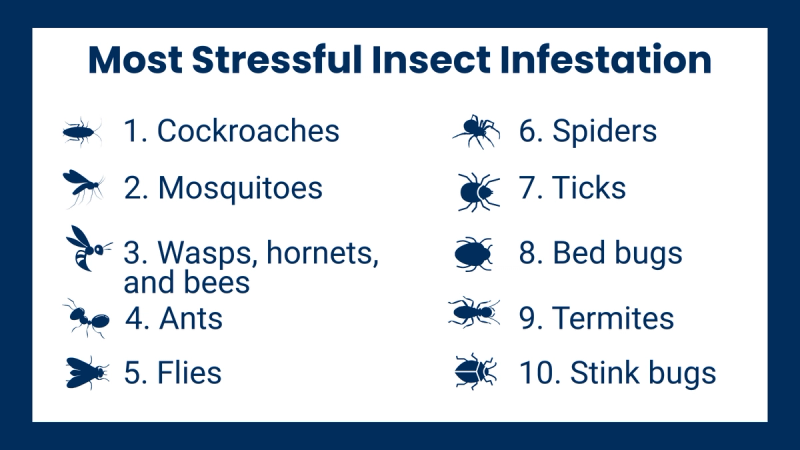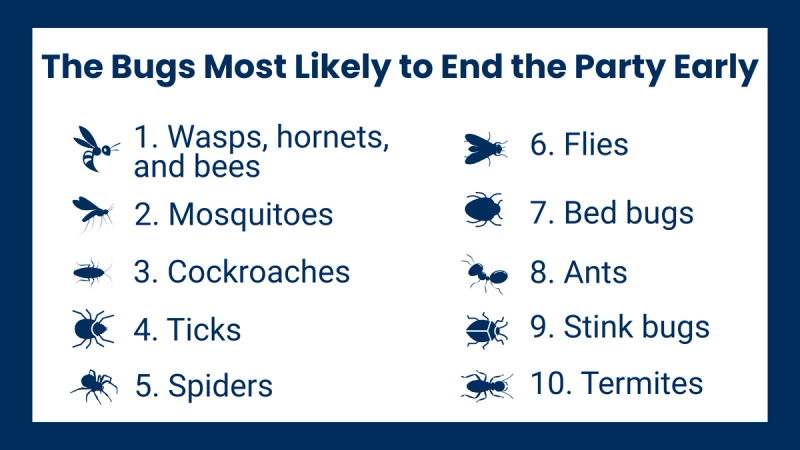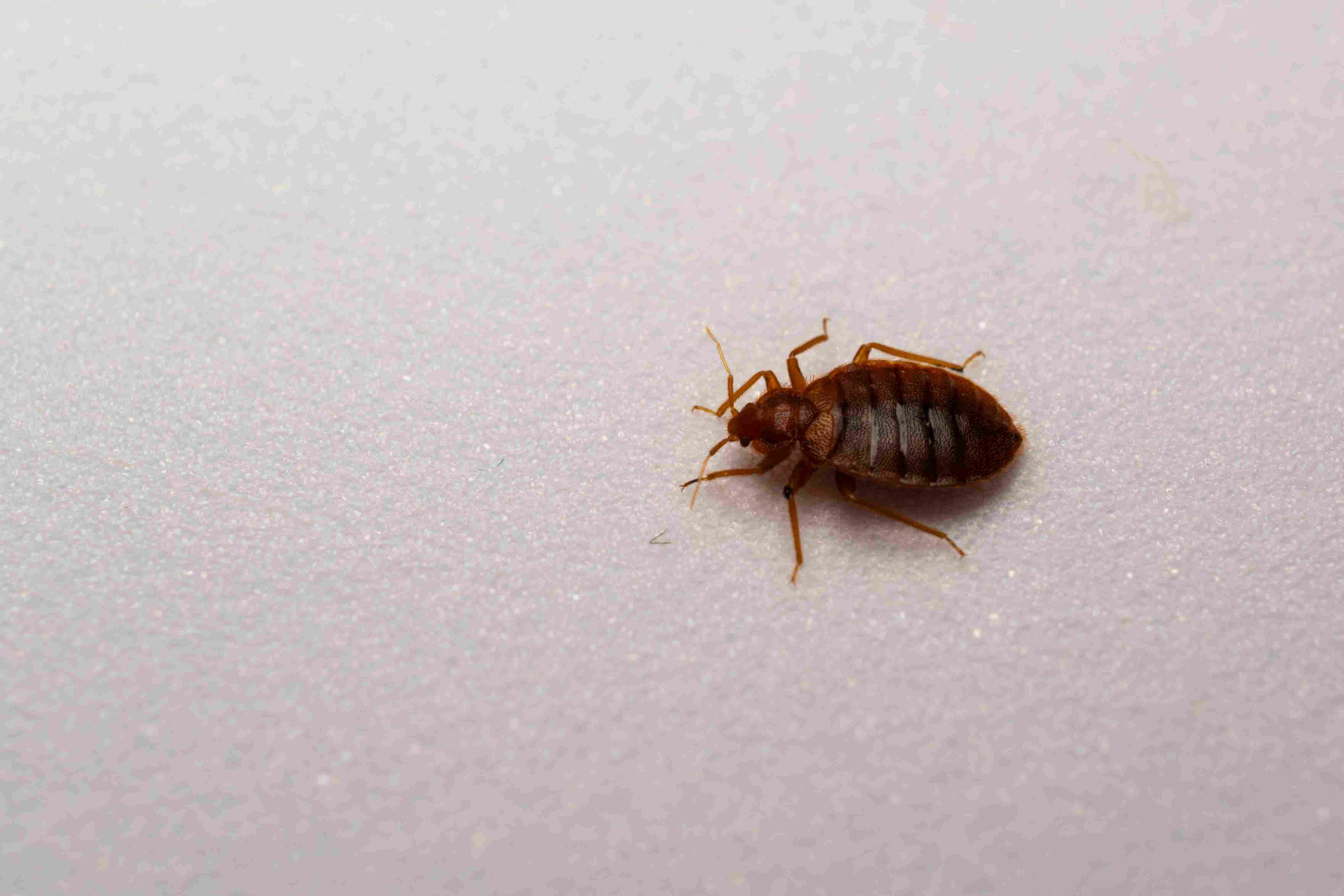Bugs aren't just gross — they’re disruptive, destructive, and sometimes dangerous. Invasive pests cause $120 billion in damage every year, according to the U.S. Department of Agriculture. Meanwhile, bloodsuckers like ticks and mosquitoes can carry serious diseases, and common household pests like ants and cockroaches can stress homeowners across the country.
To find out which pests Americans loathe the most, we analyzed Google Trends data to pinpoint the most searched and most feared insect in every U.S. state. Then, we surveyed 1,000 Americans to learn how these pests affect their daily lives. Which bugs drive people to cancel plans or even leave their homes? Which generation is most bug-phobic? How do people react when they find something crawling across the floor? The answers may surprise you.
Key Findings
- Mosquitoes are the most hated insect in America, ranking #1 in 13 states.
- Bed bugs are the most hated in densely populated, high-travel states like California and New York — making them a top concern for both residents and visitors.
- Ants dominate the South, taking the top spot in 5 states like Alabama and both Carolinas — and more than 1 in 4 Americans report dealing with ants in their home.
- Flies earned top-hated status in 5 states, particularly across the Midwest and Northeast.
- 63% of Americans believe climate change is causing local pest problems to increase.
- 1 in 10 Americans will accidentally eat a bug in their own home, showing just how unavoidable infestations can be.
- 1 in 4 Gen Z Americans say they’ve moved out of a home due to bug infestations.
The Most Hated Bug in Every Single State in America
The Ant Invasion: 3 in 10 Americans Battled Ants Indoors Last Year
Ants top the list of indoor pest problems in the U.S., with more than 1 in 4 Americans (28%) reporting ant issues inside their homes last year. In fact, 57% said they dealt with ants, spiders, or cockroaches in the past 12 months.
While ants were the most common pest overall, Gen Z broke the trend: 25% of Gen Zers reported cockroach infestations, while only 21% said ants were their biggest issue.
Google Trends supports the surge in ant activity. States with the most searches for ant problems include:
- North Carolina
- Hawaii
- South Carolina
- Louisiana
Warmer weather brings a spike in indoor infestations, with nearly 2 in 3 Americans (63%) reporting they spot bugs in their homes several times a week during spring and summer. For more than 1 in 4 (27%), these bugs are a daily nuisance once the temperatures rise.
The past two years, 2023 and 2024, have gone down as the hottest on record. With rising temperatures, many pests are becoming more active — and more noticeable.
Over 1 in 3 Americans (36%) say their pest problems have worsened in the past three years. But not everyone is feeling the heat: 54% say they haven’t noticed any major changes in their indoor bug populations.
Young Renters Say Their Places Are Bug Magnets
When asked if local pest problems have gotten worse in the past three years, 37% of Gen Z say yes — more than any other generation. In comparison, just 25% of millennials and only 14% of baby boomers feel the same.
What could be driving this perception? Nearly half (48%) of Gen Z respondents are renters, well above the 32% average across all respondents. Since renters often have less control over pest prevention, this may help explain their heightened concern.
Regional trends also offer clues. Google search interest in bed bugs is highest in travel-heavy states like Nevada, New York, and New Jersey. Scorpion searches peak in Arizona, while cockroach searches are most common in warm-weather states such as Hawaii, Florida, Georgia, and South Carolina.
Younger Americans Blame Climate Change for Rising Infestations
Bugs thrive in warm weather, and 63% of Americans believe climate change is making things worse — with higher temperatures come larger bug populations.
But opinions vary sharply by generation:
- 76% of Gen Z say climate change is making pest problems worse.
- 73% of millennials say climate change is making pest problems worse.
- 60% of Gen Xers say climate change is making pest problems worse.
- 47% of baby boomers say climate change is making pest problems worse.
Extreme temperature changes brought on by global warming can cause explosions in the insect population, leading to more infestations. Shorter winters also give insects more time to breed, leading to longer seasons for many pests, including mosquitoes.
So it does appear that Gen Z and millennials are correct in their assumptions that global warming means more pests and longer stinging and biting seasons.
Stress Scale: Bed Bugs Are the Nightmare, Mosquitoes the Menace
Some insects are just a nuisance. Others instantly trigger anxiety (and maybe a leap in the air). So, which household pests cause the biggest spike in stress when they invade our homes?

Americans know there’s a difference between creepy and dangerous. When it comes to health and safety risks, some pests are far more than a nuisance. So, which bugs do people see as the biggest threat?
- Mosquitoes: 37%
- Ticks: 19%
- Cockroaches: 14%
- Bed bugs: 11%
- Wasps, hornets, and bees: 8%
When it comes to pests, fear isn’t just experienced internally; sometimes, it’s enough to make people leave the room entirely or cancel plans on the spot.
So, which insects are most likely to send Americans packing?

Are these fears justified? Roaches can carry harmful bacteria, ticks can cause Lyme disease, and mosquitoes can cause itchy bites and can transmit potentially deadly illnesses. Because of the possible consequences, these creatures may deserve their reputations.
And then there’s the nightmare scenario: not just seeing a bug, but accidentally eating one. For 1 in 10 Americans (12%), that unsettling experience is a reality.
Sure, some pests trigger panic — but others might just be misunderstood. Which bugs do Americans think deserve a better reputation?
- Spiders: 33%
- Bees, hornets, and wasps: 18%
- Ants: 16%
- Stink bugs: 10%
- Flies: 8%
Half of Gen Z Say Insects “Really Bother” Them at Home
For roughly 1 in 3 Americans (30%), sharing their living space with bugs is more than an inconvenience — it’s a major source of anxiety. For the other two-thirds, it’s mostly just an annoyance, not something that keeps them up at night.
But age plays a big role in how people react to bugs at home. Nearly half of Gen Z (47%) say they’re seriously bothered by insects in their living space — more than three times the rate of baby boomers (13%). For younger Americans, pests aren’t just annoying — they’re a major source of stress.
Even for those who can’t stand bugs, many still see them as the lesser evil compared to other everyday nuisances. When asked which issue they’d least mind dealing with at home, here’s how bugs stacked up against other common household problems:
- Noisy neighbors: 54%
- Bugs/insects: 25%
- Bad odors: 9%
- Mold/mildew: 8%
- Rodents: 4%
Spray, Squish, or Set Free? How We React in the Moment
So, what do people actually do when they spot a bug in their home? For nearly half (48%) of Americans, it’s instant kill action — no questions asked. But not everyone reaches for a shoe. Here’s how people typically respond when a creepy crawler makes an appearance:
- Kill it immediately: 48%
- Figure out what kind of bug it is: 18%
- Grab the bug spray: 15%
- Catch and release it outside: 11%
- Ask someone else to deal with it: 4%
For many, spotting a bug is more than a household chore — it’s an emotional moment. While most people feel relief or even satisfaction after dealing with an insect, 1 in 7 still feel grossed out or uneasy even after it’s gone.
That lingering discomfort is especially common among younger generations: 20% of Gen Z and 19% of millennials say they stay uneasy post-bug encounter. In contrast, just 5% of baby boomers feel the same, suggesting that bug squeamishness fades with age. Gen X splits the difference at 14%, leaning slightly closer to the younger crowd.
Lifestyle Shake-ups: From Wardrobe Changes To Canceled Camping Trips
Younger generations may be the most bug-averse, but it’s not just about being grossed out — bugs actually change people’s behavior. More than 3 in 5 (64%) say they’ve altered their plans because of insects. Whether it’s canceling a trip, relocating a picnic, or dressing differently to avoid bites, bugs are more than a nuisance — they’re a lifestyle disruptor.
1 in 10 say they’ll be camping less this year — and bugs are the reason why.
Most people expect to deal with bugs outdoors, but for nearly 1 in 10 Americans, they’d actually prefer to encounter a bug inside, where they feel more in control. Among Gen Z, that number jumps to 1 in 5, suggesting younger generations may prefer a bug they can swat over one they can’t escape.
The Cost of Crawlers: Gen Z and Millennials Twice as Likely To Spend $50+ Each Summer
Before it ever comes to grabbing a shoe, most Americans are actively trying to keep bugs out of their homes in the first place. From sealing up entry points to using sprays and traps, here’s how people are working to keep the creepy crawlies outdoors where they belong:
Of course, DIY methods only go so far. When the problem gets out of hand, many people turn to the pros. So, how common is it to bring in an exterminator?
While service contracts can make pest control more convenient and cost-effective, only about 1 in 5 Americans (22%) have one in place. The vast majority — 78% — prefer to pay per visit, opting for pest control only when the problem becomes unavoidable.
And for those who skip a contract and pay as needed, those individual costs can add up, especially during bug-heavy seasons. So, how much are people actually spending to deal with insects during the warmer months?
When you consider that 44% of Americans spend $50 or more per month battling bugs at home, a service contract might start to sound like a smart investment. Gen Z leads the way in pest control spending, with 57% shelling out $50 or more monthly. Baby boomers, on the other hand, take a more budget-friendly approach — only 25% report spending that much.
Exterminator costs and quality can vary widely. A good pest control team will use proven methods and technology to ensure effective treatments that actually bring lasting results and value to their customers.
One-Third of Gen Zers Have Moved Out Due to Insects
While most bug problems are manageable, some become serious enough to drive people out of their homes, at least temporarily. So, how common is it to pack up and leave because of an infestation? Here’s what Americans are saying:
- Yes, I’ve had to leave on multiple occasions: 6%;
- Yes, I’ve had to leave once: 16%;
- No, but I’ve wanted to: 14%;
- No, never had to: 64%.
Gen Z is the most likely to evacuate over a bug problem, with more than 1 in 3 (35%) saying they’ve temporarily left their home due to an infestation.
Bug-related evacuations are far more common among lower-income households. Nearly 1 in 3 people earning $50,000 or less have had to leave their homes due to an infestation, compared to just 9% of those earning $150,000 or more.
So what kinds of bugs are such a nuisance that they’re making people pack up and leave? Here’s the breakdown of which infestations were serious enough to force a temporary evacuation:
- Cockroaches: 30%;
- Bed bugs: 18%;
- Ants: 13%;
- Mosquitoes: 9%;
- Spiders: 8%;
- Termites: 6%;
- Wasps, hornets, or bees: 6%;
- Flies: 6%;
- Ticks: 5%.
Bugs are an issue for Americans, but simple steps and effective pest control services can limit the hassle of both annoying and potentially dangerous bugs in and around people’s homes.
Methodology
For this article, we first analyzed Google Trends data, examining insect search trends by state, and then gathered survey responses about Americans’ most detested bugs from 1,000 adults across the country. Respondents came from the West, Midwest, South, and Northeast and represented every adult generation, from baby boomers to Gen Z.
Our questions covered both actual insect issues as well as perceptions about how serious the problems were in each survey-taker’s area. We also explored how people felt about bugs, understanding that those with a negative opinion might be more likely to consider insects a problem than those who thought of them as a normal part of nature.
Finally, our analysis covered the steps people took to avoid bug problems, from canceling travel plans to using insect repellent to hiring pest control professionals. The survey and resulting data allowed us to get a complete picture of people's relationship with common insects.
Fair Use Policy
Users are welcome to utilize the insights and findings from this study for noncommercial purposes, such as academic research, educational presentations, and personal reference. When referencing or citing this article, please ensure proper attribution to maintain the integrity of the research. Direct linking to this article is permissible and encouraged to facilitate access to the original source of information.
For commercial use or publication purposes, including but not limited to media outlets, websites, and promotional materials, please contact the authors for permission and licensing details. We appreciate your respect for intellectual property rights and adherence to ethical citation practices. Thank you for your interest in our research.










































.jpg)




